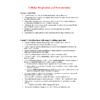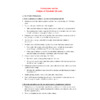|
|
Search Resources (109 Results)
 |
|
Lecture Notes | Approved: 6 years ago | 44.06 kB | Comments: 0
...living cells require energy from outside sources....
...from outside sources. Energy enters most ecosystems...
...harvest the chemical energy stored in organic...
...Catabolic pathways yield energy by oxidizing organic...
...metabolic pathways release energy stored in complex...
...compounds possess potential energy as a result...
...are rich in energy to simpler waste...
...that have less energy. Some of the...
...of the released energy is used to...
...+ H2O + energy (ATP + heat)....
...+ 6H2O + energy (ATP + heat)...
...Some of this energy is used to...
...Redox reactions release energy when electrons move...
...food molecules, releasing energy that is used...
...all oxidizing agents. Energy must be added...
...atom, the more energy is required to...
...electron loses potential energy when it shifts...
...methane, releases chemical energy that can do...
...electrons lose potential energy along the way,...
...the way, and energy is released. Organic...
...“hilltop” electrons, whose energy may be released...
...“fall” down an energy gradient when they...
...to oxygen, the energy state of the...
...to a lower energy state, releasing energy...
...energy state, releasing energy that becomes available...
...synthesis. The main energy-yielding foods, carbohydrates and...
...barrier of activation energy. Without this barrier,...
...O2. If activation energy is supplied by...
...barrier of activation energy, allowing sugar to...
...of their potential energy in this process....
...respiration represents stored energy. This energy is...
...stored energy. This energy is tapped to...
...“fall” down an energy gradient from NADH...
...release of heat energy that occurs when...
...spark for activation energy), cellular respiration uses...
...O2 into several energy-releasing steps. The electron...
...to the “top” higher-energy end of the...
...At the “bottom” lower-energy end, oxygen captures...
...reaction with a free-energy change of ?53...
...fall down an energy gradient in the...
...respiring cells deriving energy from glucose use...
...the chain, the energy released at each...
...kcal/mol of free energy. Respiration uses the...
...large denomination of energy contained in glucose...
...The quantity of energy in ATP is...
...appropriate for the energy level of work...
...Glycolysis harvests chemical energy by oxidizing glucose...
...phases. In the energy investment phase, the...
...ATP. In the energy payoff phase, this...
...present, the chemical energy stored in pyruvate...
...cycle completes the energy-yielding oxidation of organic...
...of the original energy in glucose is...
...has little chemical energy. The remaining two-carbon...
...a high potential energy. The reaction of...
...CoA to yield lower-energy products is highly...
...of the chemical energy is transferred to...
...and FADH2, transfer high-energy electrons to the...
...supplies the necessary energy for the phosphorylation...
...most of the energy extracted from glucose....
...phosphorylation, which uses energy released by the...
...drop in free energy as they pass...
...have lower free energy and are added...
...at a lower energy level than those...
...about one-third less energy for ATP synthesis...
...break the large free-energy drop from food...
...steps that release energy in manageable amounts....
...electron transport and energy release to ATP...
...ATP as an energy source to transport...
...synthase uses the energy of an existing...
...process, in which energy stored in the...
...chain is an energy converter that uses...
...Chemiosmosis is an energy-coupling mechanism that uses...
...mechanism that uses energy stored in the...
...In mitochondria, the energy for proton gradient...
...cellular respiration, most energy flows as follows:...
...pyruvate contributes enough energy to the proton-motive...
...of the stored energy is lost as...
...remarkably efficient in energy conversion. For example,...
...25% of the energy stored in gasoline...
...in gasoline to energy that moves the...
...transport chain, the energy still stored in...
...harvests much more energy from each sugar...
...can also harvest energy stored in fats...
...glycolysis. The rich energy of fatty acids...
...broad context of energy flow and chemical...
...in ecosystems. The energy that keeps us...
...These processes tap energy that was stored...
| N/A |
189
|
johaneswijaya
|
 |
|
Lecture Notes | Approved: 6 years ago | 44.31 kB | Comments: 0
...or community phenomena: energy flow and chemical...
...and chemical cycling. Energy enters most ecosystems...
...converted to chemical energy by autotrophs, passed...
...dead organisms. Because energy, unlike matter, cannot...
...continuous influx of energy from an external...
...usually the sun. Energy flows through ecosystems,...
...Physical laws govern energy flow and chemical...
...the transformations of energy and matter within...
...thermodynamics states that energy cannot be created...
...organisms convert solar energy to chemical energy,...
...energy to chemical energy, but the total...
...total amount of energy does not change....
...total amount of energy stored in organic...
...the total solar energy intercepted by the...
...ecology computes such energy budgets and traces...
...budgets and traces energy flow through ecosystems...
...that control these energy transfers. Transfers help...
...every exchange of energy increases the entropy...
...the universe. Some energy is lost as...
...efficiency of ecological energy conversions can be...
...mass, matter, like energy, cannot be created...
...over time. Unlike energy, chemical elements are...
...open systems, absorbing energy and mass and...
...the routes of energy flow and chemical...
...of nutrition and energy. Autotrophs, the primary...
...that use light energy to synthesize sugars...
...on them for energy. Herbivores that eat...
...heterotrophs that get energy from detritus, nonliving...
...exhausted. Concept 55.2 Energy and other limiting...
...amount of light energy converted to chemical...
...converted to chemical energy by autotrophs in...
...sunlight as their energy source. An ecosystem’s...
...source. An ecosystem’s energy budget depends on...
...producers use light energy to synthesize organic...
...ecosystem. A global energy budget can be...
...intensity of solar energy striking Earth varies...
...converted to chemical energy by photosynthesis. Despite...
...amount of light energy converted to chemical...
...converted to chemical energy by photosynthesis per...
...production minus the energy used by the...
...the stored chemical energy that is available...
...be expressed as energy per unit area...
...amount of solar energy available to drive...
...crop. Concept 55.3 Energy transfer between trophic...
...amount of chemical energy in consumers’ food...
...of animals as energy transformers with this...
...production is the energy stored in biomass...
...is the total energy taken in, not...
...percentage of food energy that is not...
...use so much energy to maintain a...
...because they include energy lost through respiration...
...and also the energy in organic material...
...90% of the energy available at one...
...If 10% of energy is transferred from...
...10% of that energy is transferred to...
...progressive loss of energy along a food...
...of the chemical energy fixed by photosynthesis...
...multiplicative loss of energy in a food...
...top-level carnivores because energy transfers are so...
...The dynamics of energy flow through ecosystems...
...water by solar energy, condensation of water...
...ATP and other energy-storing molecules. Phosphorus is...
| N/A |
218
|
johaneswijaya
|
 |
|
Lecture Notes | Approved: 6 years ago | 68.91 kB | Comments: 0
...for release of energy during respiration occur...
...a release of energy E.g. Digestion of...
...reserve to release energy during seed germination....
...products have less energy than the substrates....
...an input of energy to get the...
...not spontaneous). The energy required to initiate...
...called the activation energy. When the substrate(s)...
...has a higher energy level than either...
...often supply the energy required for a...
...and lower activation energy. The...
...providing the activation energy continues at a...
...provides more kinetic energy to the molecules...
| N/A |
144
|
johaneswijaya
|
 |
|
Lecture Notes | Approved: 6 years ago | 33.98 kB | Comments: 0
...bonds, release of energy (Exergonic) . Energy...
...energy (Exergonic) . Energy is released to...
...covalent bonds, requires energy input (Endergonic) ....
...input (Endergonic) . Energy is from ATP...
...Spontaneous because of Energy Gradient in Substrate...
...spontaneous however, because energy in molecular motion...
...overcome covalent bond energy. Need an input...
...an input of energy or the removal...
...removal of the energy difference. This energy...
...energy difference. This energy is referred to...
...to as Activation Energy. Regulation of catabolic...
...removing the activation Energy using Enzymes. Enzymes:...
...and reduce activation energy are unchanged during...
...Spontaneous Catabolic Reactions (Energy Generating) Respiration :...
...a source of energy. There are two...
...photon of light energy the chlorophyll becomes...
...PSII generates ATP energy PSI generates reducing...
...where materials and energy are acquired from...
...Transmission of Information Energy transformations All of...
...all capable of Energy transformations. Biosynthesis and...
...transformations. Biosynthesis and energy transformations in biochemistry...
| N/A |
122
|
johaneswijaya
|
 |
|
Lecture Notes | Approved: 6 years ago | 22.63 kB | Comments: 0
...work that requires energy, the energy for...
...requires energy, the energy for this movement...
...gradient and therefore energy available) In Hypertonic...
...gradient and therefore energy available. In Hypotonic...
...gradient and therefore energy available. In this...
...cells require cellular energy to move materials....
...that driving force (energy ) – concentration...
...gradients provide the energy. Active transport Similar...
...carrier proteins, but energy not a result...
...of materials 2. Energy Transformations ( Respiration...
...Secondary lysosome required. Energy Generating Organelles: Mitochondria...
| N/A |
169
|
johaneswijaya
|
 |
|
Lecture Notes | Approved: 6 years ago | 148.89 kB | Comments: 0
...Used to release energy during respiration and...
...storage of chemical energy. Monosaccharides (Such as...
...Glucose: C6H12O6 Main energy source for cells...
...for cells Releases energy during respiration (Mitochondria)...
...borken down when energy is needed. Cellulose:...
...used to provide energy. Amino Acids Subunits...
...a source of energy and for the...
...the storage of energy. Releases twice as...
...twice as much energy per gram as...
| N/A |
128
|
johaneswijaya
|
 |
|
Lecture Notes | Approved: 6 years ago | 44.94 kB | Comments: 0
Category: Botany | Downloaded: 0
...to capture light energy from the sun...
...it to chemical energy stored in sugars...
...a source of energy to synthesize organic...
...of the sun’s energy from the distant...
...Photosynthesis converts light energy to the chemical...
...to the chemical energy of food Photosynthetic...
...absorption of light energy during photosynthesis. The...
...12H2O + light energy C6H12O6 + 6O2+...
...6H2O + light energy C6H12O6 + 6O2...
...H2O + light energy + O2, where...
...During cellular respiration, energy is released from...
...electrons lose potential energy as they “fall”...
...mitochondrion harnesses that energy to synthesize ATP....
...increase in potential energy as they move...
...the process requires energy. The energy boost...
...requires energy. The energy boost is provided...
...(photo) convert solar energy to chemical energy....
...energy to chemical energy. The Calvin cycle...
...cycle (synthesis) uses energy from the light...
...photophosphorylation. Thus, light energy is initially converted...
...converted to chemical energy in the form...
...and ATP, the energy currency of cells....
...chloroplast uses light energy to make sugar...
...reactions convert solar energy to the chemical...
...to the chemical energy of ATP and...
...form of electromagnetic energy or radiation. Like...
...forms of electromagnetic energy, light travels in...
...fixed quantities of energy. The amount of...
...The amount of energy packaged in a...
...wavelengths pack more energy. Although the sun...
...light and transfer energy to chlorophyll a....
...and funnels the energy from these wavelengths...
...can funnel the energy from other wavelengths...
...dissipate excessive light energy that would otherwise...
...with more potential energy. The electron moves...
...are those whose energy matches exactly the...
...matches exactly the energy difference between the...
...electron. Because this energy difference varies among...
...second, releasing heat energy. In isolation, some...
...absorption of light energy produces very different...
...a photon, the energy is transferred from...
...to a higher energy level, the primary...
...chloroplast, the potential energy represented by the...
...unit, converting light energy to chemical energy....
...energy to chemical energy. There are two...
...in using light energy to generate ATP...
...to a higher energy state. This electron...
...to a lower energy level, their energy...
...energy level, their energy is harnessed to...
...chemiosmosis. Meanwhile, light energy has excited an...
...power of these high-energy electrons to the...
...to provide chemical energy in the form...
...process transforms redox energy to a proton-motive...
...In mitochondria, the high-energy electrons dropped down...
...to transfer chemical energy from food molecules...
...chloroplasts transform light energy into the chemical...
...into the chemical energy of ATP. The...
...have low potential energy, to NADPH, where...
...have high potential energy. The light-driven electron...
...membrane converts light energy to chemical energy...
...energy to chemical energy stored in ATP...
...uses the chemical energy of ATP and...
...is anabolic, using energy to build sugar...
...cycle spends the energy of ATP and...
...stores more potential energy. For every three...
...light to chemical energy. Although rubisco normally...
...reactions capture solar energy and use it...
...carbon dioxide. The energy that enters the...
...stored as chemical energy in organic compounds....
...plant with chemical energy and carbon skeletons...
| N/A |
279
|
johaneswijaya
|
 |
|
Lecture Notes | Approved: 6 years ago | 34.58 kB | Comments: 0
...how they obtain energy and carbon Nutrition...
...an organism obtains energy and a carbon...
...that use light energy are phototrophs. Species...
...Species that obtain energy from chemicals in...
...These categories of energy source and carbon...
...that harness light energy to drive the...
...but they obtain energy by oxidizing inorganic...
...molecules for both energy and carbon. This...
...require only light energy, CO2, N2, water...
...that obtained their energy and carbon molecules...
...which can extract energy from organic fuels...
...could harness the energy of sunlight to...
...thermophilies. Methanogens obtain energy by using CO2...
| N/A |
205
|
Guest
|
 |
|
Lecture Notes | Approved: 6 years ago | 35.64 kB | Comments: 0
...different forms of energy such as light,...
...transduce (convert) the energy of the stimulus...
...when the stimulus energy causes a change...
...a receptor cell: energy ? receptor potential....
...channels Amplification Stimulus energy that is too...
...they respond (the energy they transduce). Mechanoreceptors...
...respond to mechanical energy, e.g. pressure, touch,...
...Electroreceptors detect electrical energy. Thermoreceptors detect changes...
...cochlea transduces the energy of a vibrating...
...flex utilizing the energy released by ATP,...
...steady supply of energy. They have many...
...muscles. LOCOMOTION REQUIRES ENERGY TO OVERCOME FRICTION...
...place. Locomotion requires energy to overcome friction...
...be the most energy efficient method of...
...leg muscles spend energy to propel the...
| N/A |
160
|
Guest
|
 |
|
Lecture Notes | Approved: 6 years ago | 59.3 kB | Comments: 0
...the expenditure of energy, and in some...
...versus losses for energy and materials Like...
...that must exchange energy and materials with...
...outward flows of energy and materials are...
...animal’s input of energy and materials only...
...total flow of energy and materials by...
...part of the energy and material flow...
...of its annual energy budget on reproduction....
...of materials and energy exchange. Because homeostasis...
...of materials and energy, it can be...
...heat budget, an energy budget, a water...
...so on. Most energy and materials budgets...
...and lowers the energy cost of keeping...
...large amount of energy necessary for heat...
...must expend considerable energy to keep warm...
...5. Torpor reserves energy during environmental extremes...
...to balance heat, energy, and materials budgets....
...animals can save energy while avoiding difficult...
...of time on energy, stored in body...
...the amount of energy they need to...
...rates, and high energy consumption when active....
...coupled to the energy budget and depends...
...animals must expend energy to produce it...
...4. Osmoregulators expend energy to control their...
...osmoregulation has an energy cost. Because diffusion...
...osmoregulators must expend energy to maintain the...
...active transport. The energy costs depend mainly...
...possible because considerable energy is expended by...
...thought as tiny energy-consuming machines whose function...
...closely linked with energy budgets and temperature...
...gas exchange, and energy balance. Under some...
| N/A |
163
|
Guest
|
|
Post your homework questions and get free online help from our incredible volunteers
918 People Browsing
114 Signed Up Today
|